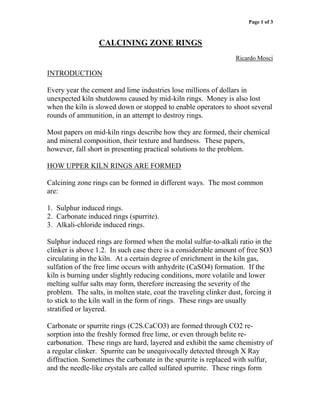
Calcining Zone Rings
- 1. Page 1 of 3 CALCINING ZONE RINGS Ricardo Mosci INTRODUCTION Every year the cement and lime industries lose millions of dollars in unexpected kiln shutdowns caused by mid-kiln rings. Money is also lost when the kiln is slowed down or stopped to enable operators to shoot several rounds of ammunition, in an attempt to destroy rings. Most papers on mid-kiln rings describe how they are formed, their chemical and mineral composition, their texture and hardness. These papers, however, fall short in presenting practical solutions to the problem. HOW UPPER KILN RINGS ARE FORMED Calcining zone rings can be formed in different ways. The most common are: 1. Sulphur induced rings. 2. Carbonate induced rings (spurrite). 3. Alkali-chloride induced rings. Sulphur induced rings are formed when the molal sulfur-to-alkali ratio in the clinker is above 1.2. In such case there is a considerable amount of free SO3 circulating in the kiln. At a certain degree of enrichment in the kiln gas, sulfation of the free lime occurs with anhydrite (CaSO4) formation. If the kiln is burning under slightly reducing conditions, more volatile and lower melting sulfur salts may form, therefore increasing the severity of the problem. The salts, in molten state, coat the traveling clinker dust, forcing it to stick to the kiln wall in the form of rings. These rings are usually stratified or layered. Carbonate or spurrite rings (C2S.CaCO3) are formed through CO2 re- sorption into the freshly formed free lime, or even through belite re- carbonation. These rings are hard, layered and exhibit the same chemistry of a regular clinker. Spurrite can be unequivocally detected through X Ray diffraction. Sometimes the carbonate in the spurrite is replaced with sulfur, and the needle-like crystals are called sulfated spurrite. These rings form
- 2. Page 2 of 3 whenever the partial pressure of CO2 above the bed of material is high enough to invert the calcining reaction. In coarsely ground, silica-rich raw mix, the free lime does not have sufficient time in the calcining zone to react with silica, therefore increasing the chances for spurrite deposits. The third type of calcining zone ring occurs whenever the sulfur-to-alkali molar ratio is below 0.83, or in kilns with a heavy chlorine load. In these cases the low-melting potassium salt Sylvite (KCl) provides the binder for ring formation. Through a freeze-and-thaw mechanism, these rings can assume massive proportions, sometimes blocking the entire kiln opening. Alkali rings are by far less common than other types because sulfur and carbonates are usually in excess of potassium. In lime recovery kilns for example, where alkali is always in excess of sulfur, severe ringing and balling sometimes occur. THE RefrAmerica SOLUTION TO CALCINING ZONE RINGS Since the conditions that lead to calcining zone ring formation can rarely be changed, the solution to the problem is to work on the consequence: to continually destabilize the ring as it forms. To do so, RefrAmerica developed a load tumbling system. The tumblers are pre-cast and pre-fired, before being welded to the kiln shell at varying angles. The most common angles are 90 degrees and 60 degrees. The space between tumblers is lined with abrasion-resistant fireclay brick. The tumbling and mixing action changes the thermal and chemical profile of the kiln load, therefore slowing down C2S sulfation and carbonation. Even if the chemical reactions occur the tumbling action mechanically interrupts the continuity of the buildup. Once the continuity is broken, the ring can easily be removed under kiln rotation. The pre-cast tumblers are made with non-sticking silicon carbide or zircon low cement castables of high density. Figure 1 displays part of a tumbling zone during a kiln stoppage.
- 3. Page 3 of 3 Figure 1 – Silicon carbide tumbler in contact with the brown ring material. Figure 2 shows a massive ring in the background, past the tumbler area, and a clean lining between tumblers in the foreground. This ring was 2 ft. high and extended through 10 ft. of kiln length, above and below the tumbler section. Figure 2 – The clear effect of tumblers on ring elimination.